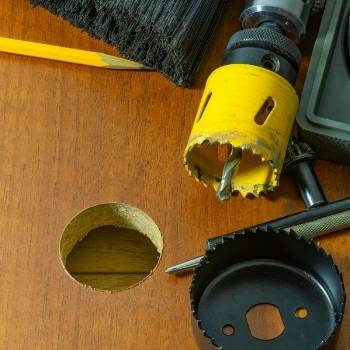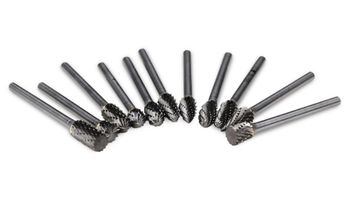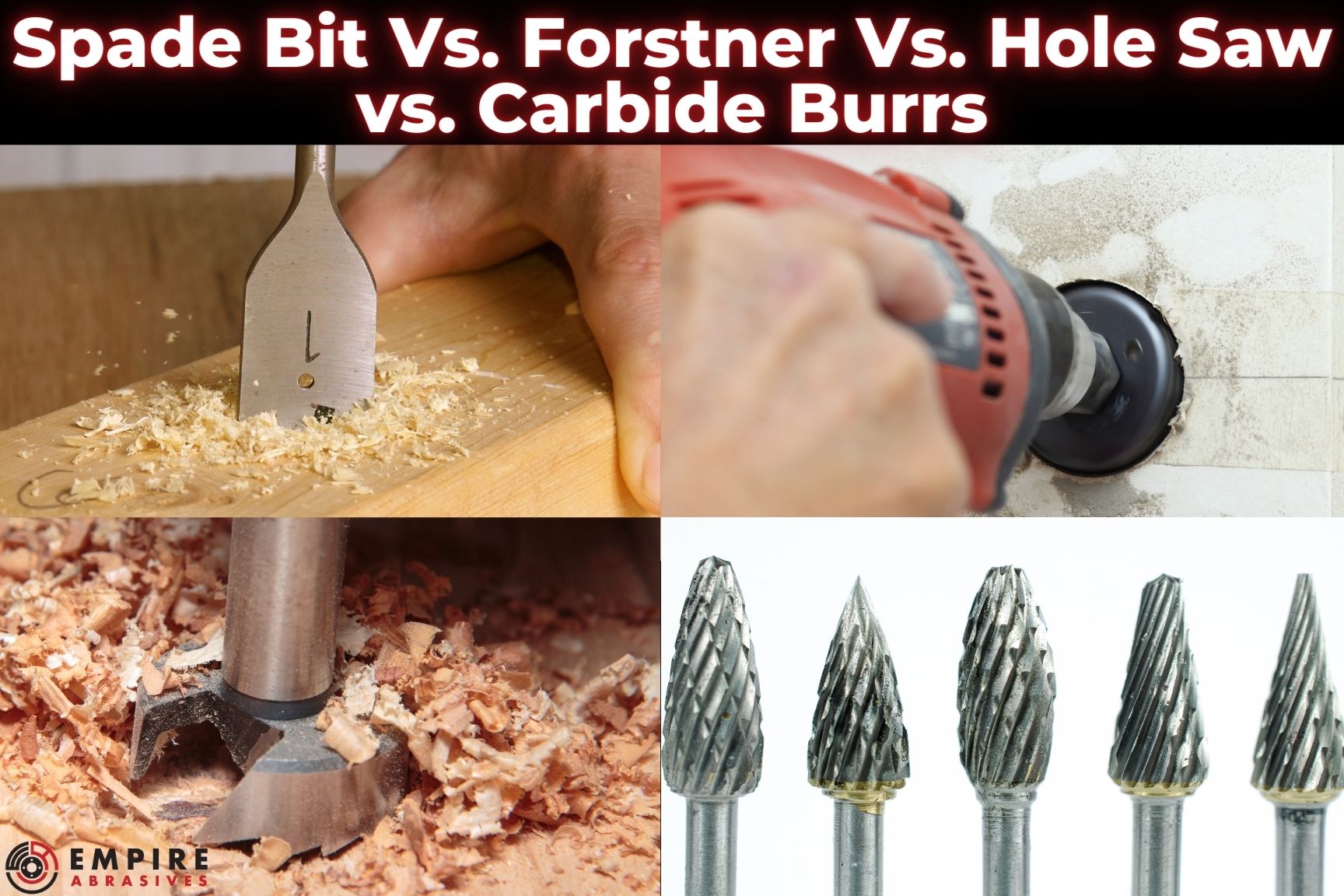
If you’re new to woodworking, you may not always know when it’s the best time to use a spade bit, Forstner, hole saw, or a carbide burr.
The first three of these tools serve a similar purpose—to drill holes in wood—but they can create holes of different types, sizes, and roughness. The burrs serve a different purpose for woodworkers.
Fortunately, once you have a general understanding of how to distinguish these four essential tools, knowing when and how to utilize them will be pretty easy.
What Are They?
Knowing the main functions of the spade bit, Forstner bit, and hole saw are the key to utilizing them properly.
Spade Bit
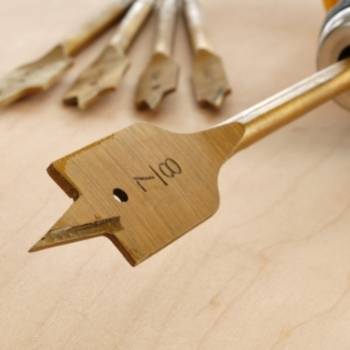
The spade bit has a shape similar to—you guessed it—a spade. Some people may also call them “paddle bits.” They have two flat blades with a sharp point in the middle, which spin rapidly and chip away at the wood to create a hole.
To use the spade bit, first attach it to the end of your drill. Pierce the wood you are drilling with the sharp point and turn on the drill, starting with a low setting. Make sure to hold it steady as you can, gradually increasing the speed of the drill as you go.
You can use the spade bit to make complete holes and flat-bottomed holes. It’s quick and efficient, but the results can be a bit messy.
Forstner
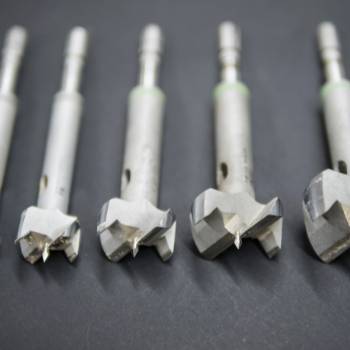
A Forstner bit, like the spade bit, is a piece that you attach to the end of your drill. Their namesake, Benjamin Forstner, invented them in 1874.
They have a single sharp point in the middle and two round blades that spin around as they shave away the wood. You can use them in a hand-held electric drill, but it is more common to use them in lathes and drill presses.
To use the Forstner bit, stick the shank in the end of your drill. Place the sharp point in the area you want to cut and slowly run it through. Make sure you don’t increase the speed too much—a huge benefit of the Forstner bit is the precision, and you will need to work slowly to achieve that.
Unlike the spade bit, the Forstner bit is ideal for creating a neat, precise cut. You can use them to create flat-bottomed holes and even overlapping holes!
Hole Saw
Despite its name, hole saws are not actual saws, but it is not quite a drill bit, either. They get their name from its circular blade with a rigid bottom similar to that of a saw.
They also have a bar in the middle called an arbor that connects the hole saw to the drill. Some hole saw arbors are installed with and some without a pilot drill in the center. The blade spins around and shears into the material, sawing out a chunk of wood and creating a hole. Some people may also call them “hole cutters.”
To use the hole saw, you will need to attach it to a corded drill or a cordless drill with at least 18 volts. If you are drilling something lightweight, make sure to anchor it down so that it does not spin. Hold the drill steady as the hole saw cuts through the wood.
One interesting feature of the hole cutter is that it does not create wood chips; instead, it simply cuts out a plug of wood. This can make cleanup a bit easier, but it also means that you cannot use it to create a flat-bottomed hole.
Carbide Burrs
Carbide burrs come in many different shapes for different purposes. The majority of them have a ¼” or ⅛” shank that attach to die grinders, rotary tools (ie Dremel), and high speed engravers.
Unlike the other 3 options in this article, carbide burrs are not generally used for boring holes. They can make holes in wood, but are going to be used for detailed work and can also be used to widen or shape an already cut hole.
What Are the Differences?
Now that you know the basics of these four tools, you might still have a few questions regarding what makes them different from each other. To help you better understand how these tools differ, we’ll compare and contrast a few different features.
Type of Cut
Choosing the right tool can depend on the type of cut you are trying to achieve.
The spade bit can create both flat-bottomed holes and complete holes. Keep in mind, though, that these holes can often be a bit rough around the edges, so if you are looking for something a bit neater, you might want to opt for one of the other two.
You can use the Forstner to create flat-bottomed holes only. These holes are also much neater than what you’d get from a spade bit.
As mentioned above, tungsten burrs aren’t meant for hole cutting. They are great for adding detail to a wood surface, rounding out edges, and wood carving to get a desired shape. A 1/4" die grinder bit can make larger cuts and grind faster, while a 1/8" die grinder bit can help create more intricate designs on metal or wood, depending on the shape of the burr's head.
Finally, the hole saw is excellent for creating complete holes. Like the Forstner, these cuts are very smooth and precise.
Sizes
In general, all four tools come in multiple sizes, but their respective size ranges tend to have limits. In some cases, though, you can create bigger holes by overlapping, so this shouldn’t be a major factor.
Spade bits are the smallest of the three hole cutting tools; they generally come in a range of ⅜ an inch and 1 ½ inches. Forstners are a bit larger; their range is from ¼ an inch to 2 ¼ inches.
The cutting diameter of a carbide burr ranges from 3/32” to 1” and only up to about 1” in cutting depth. This makes them ideal for shaping wood, but not for making large holes or cuts.
The largest option of the three hole boring tools goes to the hole saw. They can cut holes from 3/4 inches up to six inches in diameter!
Materials
For the most part, you will want to use drill bits for wood only. You can use them for softer materials like drywall, too.
The spade bit is best for softwoods. You can also use it on hardwoods, but you may not be as pleased with the results, and the spade bit is already a bit sloppy as is.
In addition, trying to bore through hardwoods can damage the tool over time. In general, it is best to stick with softwoods when using the spade bit.
Alternatively, you can use the Forstner bit on both softwoods and hardwoods. With harder types of wood, however, you will want to watch the speed—make sure to keep it low to prevent overworking the tool.
The hole saw, on the other hand, has a bit more range; most of them are also wood-only, but you can purchase hole saws for metal and masonry as well. They can also cut through both hardwood and softwood with relative ease.
A carbide bit has the most range for the materials they are compatible with. They can cut most metals and most types of wood.
Speed
These tools also come in a range of speeds. You don’t want to waste time while you’re woodworking, but you also won’t want to rush things, either.
The quickest of the options for cutting holes is the spade bit, but as mentioned earlier, that comes with the downside of splintered edges.
The slowest option is the Forstner bit; however, if you want the neat results that come with this tool, the small amount of extra time will be worth it.
The hole saw is right in the middle; it’s not particularly fast or slow.
Overall, the speed of your tool should not be a major deciding factor; woodworking will require patience no matter how fast your drill may be.
Pros and Cons
Though all of these tools have a time and a pace, they also come with pros and cons.
Spade Bit
Pros:
- It works very quickly.
- It can create both flat-bottomed holes and complete holes.
- It is less likely to overheat.
Cons:
- The edges of the holes can have frays and splinters.
- The quality of the holes can be inconsistent.
- The bit tends to wobble easily.
Forstner:
Pros:
- It is more precise than the spade bit.
- The results are neater and less likely to have splinters.
- You can drill overlapping holes.
Cons:
- It cannot cut complete holes.
- It works a bit slower than the other options.
- It can break or overheat if you are not careful.
Hole Saw
Pros:
- It does not create wood chips, which makes cleanup a bit easier.
- You can use it to cut more materials than the other options.
- It can cut bigger holes than the other two.
Cons:
- You cannot use it to make flat-bottomed holes.
- It tends to be more expensive than the other options.
- Hole saws can get stuck while they are cutting.
Carbide Burrs
Pros:
- Best for fine detail, shaping, and carving wood.
- Long product life.
- Can be reused for many different materials.
- Multiple shapes available for different tasks.
Cons:
- Not meant for boring holes.
- Fairly expensive
Summary
Now that you understand the basic features of these four tools, it should be easy to figure out when and how to utilize them.
Are you hoping for a quick, efficient cut, and you’re not particularly worried about how neat it may be? In that case, the spade bit is your best choice.
Alternatively, do you want to make a smooth, complete hole? In addition, would you like that hole to be a few inches in diameter? The hole saw is the way to go.
Do you want to make a smooth hole with a flat bottom? And are you not in too much of a hurry to get the job done? The Forstner is the one you want to choose.
Finally, if you are looking to add detail to your woodworking project or need a powerful tool for wood carving, a carbide burr set can be a great tool to have on hand.
Each of these tools has a place in your toolbox, and by understanding their unique purposes, you can make the most of them.

